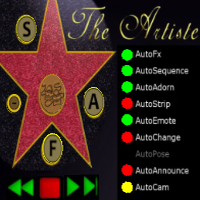
This blog is for those interested in the almost 200 features of the Artiste Performance HUD and Product Line, and the ongoing development of the Artiste Performance HUD and suite of supporting products. We will have discussions and demonstrations and try to answer questions. The main purpose is to "show" what it can do rather than describe in detail how it does what it does.
Monday, June 11, 2018
The Artiste Mover System - Move-Range - GoTo2ndMove Part 2
We learned, in the last post, the concept of move-range. We can tell our mover to move a portion of the total number of moves. We don't have to do all the moves of our mover at one time. We did the 1st move out of a total of 5 moves.
In this example we will do the 1st TWO moves out of a total of 4 moves.
A common scenario comes up where you start off placing your movers backstage so your group of dancers in your routine can easily see and pre-mount them and be ready to go onstage.
But ultimately you want them to rise up from below the stage. This means they have to somehow get to the a position below the stage.
Early mover designs dictated that once you started your move sequence, you had to finish it.
So...you COULD move from backstage to under the stage and then move up all uninterrupted... but most performers wanted their 1st official routine move to start UNDER the stage and rise up.
So what was needed was a way to start and stop the move sequence then restart it again.
The Artiste MoveRange feature, in combination with a show-time access-button that performs the 1st move and then stops, now makes this possible without the need for using extra HUDS to accomplish the starting and stopping and restarting of a move sequence.
With just one HUD, you can simplify this ordeal.
After all of the dancers are in our group we press a button on the lead-dancer's HUD to perform JUST the first move which places them UNDER the stage.
First, we make sure GoTo2ndMove is 'on' in the Palettes that we want to respond to our request in the *palette nc. Also increase the EditMoveSpeed from 0.5 to something greater as this is what is used for the GoTo2ndMove and not the speed in the *moves nc because if the time is too short, the move may not be as accurate as expected.
EditMoveSpeed,2.5
GoHomeSpeed,2.0
GoTo2ndMove,on
GroupID,AB
Then we tell the HUD that when we press Play we perform moves 02 thru 04 instead of 01 thru 04 because we have already performed the 1st move.
TRACE,on
1,r=p%sitters%mmove02-04
END
The sitters keyword sends the mmove command to all palettes that are moveable and sittable. Else we would need an autofx command for each avatar-palette-mover. See example below:
1,r=p%01_A%mmove02-04$r=p%01_B%mmove02-04
So this saves some nc line space as well as tighter palette-trigger coordination because all palettes get the command at exactly the same time, practically speaking.
So along with the "all" command there is "sitters", "non-sitters", as well as the group designations for sending moves and mmoves to select Palettes depending on their type and grouping designation.
Step 1: Press GoTo2ndMove
Step 2: Press Play
We added a 1 second pause after each move to make them more discernible.
We left out animations (i.e. 'none') to focus on just the move-range concept and how it enables the GoTo2ndMove.\ feature. There is a 5-second delay until the the 1st event fires that tells all of the seated avatars to start their 3-move trek (02-04).
*events
TRACE,off
ELAPSED
1,"Event 1",5
2,"Event 2",10
3,"Event 3",15
END
*autofx looks like this
TRACE,on
1,r=p%sitters%mmove02-04
END
*moves
M01_A,5.000000,<0.00000, -13.46509, -3.20166>,<0.00000, 0.00000, 0.00000, 1.00000>,none,1
M01_A,3.000000,<0.00000, 0.00000, 3.27832>,<0.00000, 0.00000, 0.00000, 1.00000>,none,1
M01_A,3.000000,<2.00000, -2.53491, 0.00000>,<0.00000, 0.00000, 0.00000, 1.00000>,none,1
M01_A,3.000000,<0.00000, -3.00000, 0.00000>,<0.00000, 0.00000, 0.00000, 1.00000>,none,1
*palette
DefaultSitAnim,lowbow
.
.
.
FinalMovePose,standing
See the Video
Subscribe to:
Posts (Atom)


